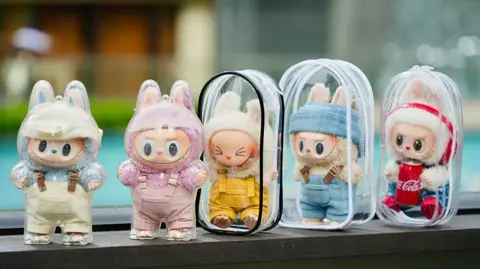**The Unlikely Success of Labubu Dolls: Adorably Quirky or Just Plain Weird?**
In recent years, a unique phenomenon has captivated audiences globally—the Labubu dolls. These quirky plush figures, hailing from the creative mind of Hong Kong-born artist Kasing Lung and produced by Chinese toy company Pop Mart, have sparked debates about their aesthetic appeal. Some find them irresistibly adorable, while others see them as bizarre representations of creature design. Nevertheless, Labubu’s journey from a niche toy to a global sensation speaks volumes about the power of culture and marketing in today’s interconnected world.
**Understanding the Labubu Craze**
Labubu, a character in Pop Mart’s “The Monsters” series, embodies an elf-like figure characterized by pointy ears, oversized eyes, and a cheeky grin flaunting precisely nine teeth. Despite their cheerful premise, the internet remains divided on their charm. The term ‘Labubu’ itself doesn’t carry any specific meaning; it’s merely a brand name that has taken the toy market by storm. These dolls have found favor with a wide array of fans, including celebrities like Rihanna, Dua Lipa, Kim Kardashian, and Lisa from the K-Pop group BLACKPINK. Even regular consumers are enamored, leading to long lines in stores and widespread excitement that has sometimes resulted in chaos.
As avid collectors compete to get their hands on these dolls—exemplified by stories like that of Fiona Zhang, who relishes the thrill of the hunt—Labubu’s popularity has soared. Such demand has significantly boosted Pop Mart’s profits, nearly tripling in just the last year alone. This uptick in sales has, according to some analysts, helped revive China’s soft power image post-pandemic and in the face of complex international relations.
**What Makes Labubu Unique?**
Despite their growing fame, many people remain puzzled about the particular elements that fuel the Labubu craze. The dolls, produced in various themed series such as “Exciting Macaron” and “Big into Energy,” come with a blend of plush bodies and vinyl heads, giving them a unique texture and look. Labubu is portrayed as a kind-hearted character, though with a humorous twist; it often inadvertently causes chaos rather than helping. The allure of the brand also stems from its associated universe of characters, including Zimomo, Tycoco, and Mokoko, who add to the narrative depth and expand collectability.
The marketing strategy employed by Pop Mart has also been intriguing. Initially gaining attention through ‘blind boxes’—mystery packages that customers open to discover a surprise doll—this method heightens the excitement and anticipation of acquiring Labubu. The initial foray into the market, however, traces back to 2010 when Wang Ning launched Pop Mart as a variety store in Beijing. Following the huge success of their other characters, they collaborated with Kasing Lung to release Labubu in 2019.
**Labubu’s Global Expansion: From China to the World**
Interestingly, Labubu’s ascent to fame coincided with China’s recovery from the COVID-19 pandemic in late 2022. This period marked a renewed desire among consumers for nostalgic and emotional escapism through whimsical products. The dolls resonated particularly well within the younger demographic, becoming a trending topic not only in China but also throughout Southeast Asia and eventually leveraging their appeal to the Western market.
As stories of Labubu began to spread across social media platforms, the dolls piqued the interest of celebrities, further bolstering their visibility. The moment when K-pop sensation Lisa showcased Labubu on her Instagram in April 2024 marked a significant turning point, leading to widespread media coverage and fan fervor. Iconic celebrities have since flaunted the dolls, with Rihanna and Kim Kardashian adding their endorsements.
**Understanding the Obsession with Labubu**
Despite Labubu’s quirky design and whimsical story, explanations for its viral success remain elusive. The phenomenon seems to merge a blend of serendipity, cultural timing, and a connection with consumers’ desires for lighthearted escape. As noted by analysts, products representing Chinese creativity, such as Labubu, can share cultural narratives in universally appealing ways. This aligns with a broader trend where unique toys and cultural exports are increasingly recognized as influential in navigating global perceptions of China.
As the Labubu craze continues to snowball, with shops and online platforms struggling to keep up with demand, it symbolizes a larger shift in how cultural products can captivate audiences worldwide. The dolls have permeated social media with unboxing videos and influencer endorsements, each interaction drawing consumers deeper into Labubu’s whimsical world. All these factors contribute to an ongoing sensation that exemplifies charming chaos in a globalized toy market.



